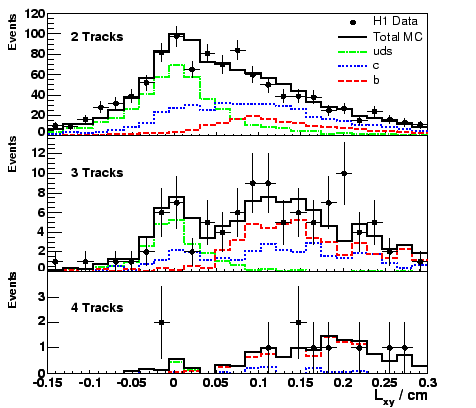Another method to separate the
quark flavours is based on the explicit reconstruction of decay vertices
in the transverse plane. In the method of deterministic
annealing [152], there is no definite
assignment of tracks to vertices, but each track is assigned a weight
with a range 0 to ![]() for each vertex candidate, using the weight
function of [153]. The larger the distance of the track
to a vertex candidate, the smaller the weight. A simultaneous fit to
a primary and a secondary vertex is made, with all tracks of the event
considered for the primary vertex, whereas only tracks associated to the
jet axis contribute to the secondary vertex.
The vertex configuration that minimizes the global fit
for each vertex candidate, using the weight
function of [153]. The larger the distance of the track
to a vertex candidate, the smaller the weight. A simultaneous fit to
a primary and a secondary vertex is made, with all tracks of the event
considered for the primary vertex, whereas only tracks associated to the
jet axis contribute to the secondary vertex.
The vertex configuration that minimizes the global fit ![]() is
found iteratively.
is
found iteratively.
 |
In fig.19 the decay length distributions are shown
for events at large ![]() with secondary vertices made up of two,
three and four tracks, respectively.
The decomposition into
with secondary vertices made up of two,
three and four tracks, respectively.
The decomposition into ![]() ,
, ![]() and
and ![]() is indicated using the
results from the fit of the negative subtraction method as described
above in section 5.5.2.
The fig.19 shows that the two methods give consistent results.
is indicated using the
results from the fit of the negative subtraction method as described
above in section 5.5.2.
The fig.19 shows that the two methods give consistent results.